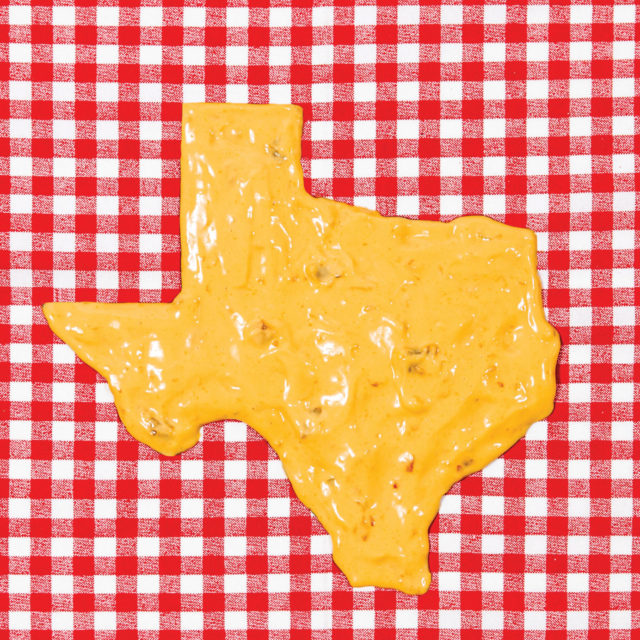Nobody knows with certainty where queso (short for chile con queso) actually comes from. There are tales of a San Antonio, Texas, restaurateur named Otis Farnsworth who developed the silken cheese dip when he supposedly created the first Tex-Mex restaurant in 1900. Others say queso was born from a 1908 Kentucky newspaper recipe for Mexican rarebit, a spicy take on another melted cheese dish, Welsh rarebit. And a few years ago, some theorists claimed queso actually hailed from an Arkansas restaurant called Mexico Chiquito (Texans were quick to dismiss that one).
Despite queso’s lack of clear-cut origins, most Texans consider it their birthright. There are many foods that are considered to be Texan, such as barbecue, breakfast tacos, or chicken-fried steak. Yet none are as widely known, cooked, consumed, and debated about by so many subsets of the state’s population as queso.
I grew up in Dallas, in an Indian vegetarian household. We couldn’t partake in barbecue, chicken-fried steak, or most varieties of breakfast tacos. But we went out for Tex-Mex constantly, and there was always queso on our table. At our favorite restaurant, Mi Cocina, the queso came with a big chip lodged right in the center, like a cheesy sword in the stone — everyone always fought over it.
Queso is a likely cousin of the Mexican dish queso fundido, a melted white cheese mixed with roasted green chilies from Chihuahua. The queso in Texas, by contrast, usually involves American cheese (typically Velveeta or Kraft extra melt) and salsa (this means Rotel, a can of diced tomatoes and green chilies). It’s a version of queso fundido that Texans made using the ingredients available to them.
Unlike a dish like barbecue, queso is not about sourcing the best quality ingredients and investing in large, fancy equipment. It is about slapping together a dip from pantry ingredients just before guests come over. Queso is unsettlingly smooth, like melted wax. It is intensely salty and just a little spicy. It’s addictive like a Jolly Rancher, where you know the flavor is artificial but you love it anyway.
In Texas, there are queso competitions (they’re called quesoffs), and 1.3 million posts on Instagram are tagged #queso. During the 2019 Super Bowl, the most viral moment for Texans had nothing to do with the game — it was news anchor Dana Perino’s sorry attempt to make queso. The resulting “I made queso” meme was deemed “the only Super Bowl meme that matters” by BuzzFeed the next day.
Every Tex-Mex chef I spoke to said that queso was a best-selling item. “My cheese bill is probably several hundred thousands of dollars annually,” says Matt Martinez, who runs the Tex-Mex chain Matt’s Rancho Martinez. “Kids drink it from a bowl.”
“It is as common as pizza here,” Martinez adds. Utter the word, “queso” to anyone in Texas, and no one is thinking of the Spanish word for cheese, he says. “We are looking for the chips.”
Queso’s wide appeal lies largely in its simple conceit. It’s an any-occasion food that’s easy to understand.
“It’s something everyone can take a part of,” says Lisa Fain, founder of the Homesick Texan blog and author of the cookbook, Queso!. Not everyone is making brisket in their backyards, Fain says, “but everyone can make queso. It is this egalitarian dish.”
In fact, a lot of Texans believe that queso requires using processed ingredients. “It is a reverse snobbery,” Fain says. “When you make it with fresh ingredients and fancy cheese, people are like, ‘That is not queso.’”
Still, some restaurants have made attempts at gussying it up. Sylvia Casares, who owns the Tex-Mex restaurant Sylvia’s Enchilada Kitchen, uses natural cheddar to up the cheese flavor in her queso, and makes a roux of vegetable oil and flour to form the creamy base. She says people can do whatever they want with queso as long as it doesn’t include butter, which she feels is a cardinal sin. At TacoDeli, the hit Texas taco chain, the queso includes milk, and the restaurant’s homemade salsa roja.
There are also various queso adaptations from Texas’s many immigrant communities. The former Dallas restaurant Chicken Moto had a popular kimchi-infused queso. Houston’s MKT Bar makes a Greek queso, made with a Greek sheep’s milk cheese called Kefalograviera. Deepa Shridhar has served Indian-inspired queso made with paneer, fermented chilies, and cardamom at her Austin pop-up and supper club, Puli Ra.
“I didn’t do it to prove anything,” Shridhar says of the dish. Adding the spices “made it taste right,” and more comforting. It is the perfect blend of her Texan and Indian backgrounds, both of which she feels are equal parts of her identity.
Queso is, after all, fusion food in and of itself — the result of a dish being brought over from Mexico and modified to suit local tastes. “We are lucky that we have all these ingredients we can play with” because of the immigrant population, Martinez says. “Doing something new is kind of what makes us great around here.”
Fain sees queso as “this basic template of Texas food. You can do so much with it.”
Shridhar says that queso is how she has gotten many people to try Indian food for the first time. She can wrap up paneer and cardamom in this familiar packaging, and people come to realize that these flavors aren’t all that intimidating.
Why queso, and not any other Texas food? “Queso is the people’s champion, the everyday food,” she says. “Queso is how we open up people’s minds.”
